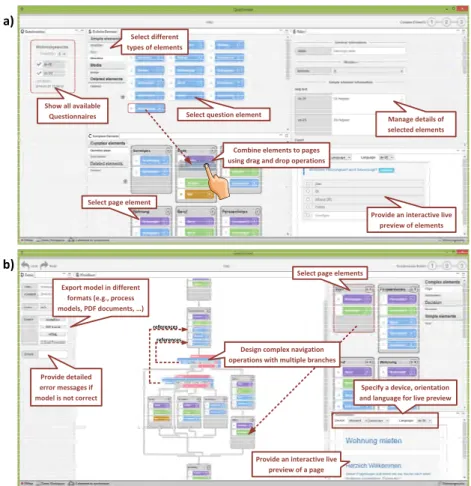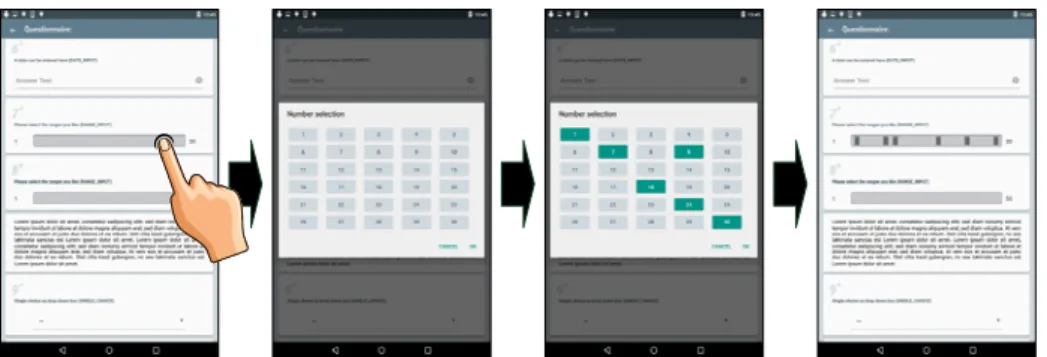A Configurator Component for End-User Defined Mobile Data Collection Processes
Johannes Schobel, R¨udiger Pryss, Marc Schickler, Manfred Reichert
Institute of Databases and Information Systems, Ulm University, Ulm, Germany {johannes.schobel, ruediger.pryss, marc.schickler, manfred.reichert}@uni-ulm.de
Abstract. The widespread dissemination of smart mobile devices offers promising perspectives for collecting huge amounts of data. When real- izing mobile data collection applications (e.g., to support clinical trials), challenging issues arise. For example, many real-world projects require support for heterogeneous mobile operating systems. Usually, existing data collection approaches are based on specifically tailored mobile ap- plications. As a drawback, changes of a data collection procedure require costly code adaptations. To remedy this drawback, we implemented a model-driven approach that enables end-users to realize mobile data col- lection applications themselves. This paper demonstrates the developed configurator component, which enables domain experts to implement digital questionnaires. Altogether, the configurator component allows for the fast development of questionnaires and hence for collecting data in large-scale scenarios using smart mobile devices.
1 Introduction
In many application scenarios (e.g., clinical trials), data collection is still based on paper-based questionnaires (so-calledinstruments), which reveal many draw- backs (e.g., huge efforts for digitizing and analyzing the data collected). Using smart mobile devices with specifically tailored services offers promising perspec- tives in this context. The development of respective mobile services, however, is both time-consuming and costly. Furthermore, the mobile support of mobile data collection scenarios often requires profound domain-specific knowledge. Hence, a generic and flexible approach to speed up the development of mobile data collection applications is demanded by domain experts [3]. In the QuestionSys project, we developed an advanced framework for supporting the lifecycle of mo- bile data collection scenarios. On one hand, IT experts are relieved from costly manual tasks (e.g., deploying mobile applications to devices). On the other, do- main experts (e.g., medical doctors) are empowered to create sophisticated data collection instruments following a process-centric approach for their design and enactment. This paper demonstrates the configurator component that enables domain experts to create sophisticated instruments for large-scale data collection scenarios.
The paper is organized as follows: Section 2 presents selected services of the framework. Section 3 discusses related work and Section 4 summarizes the paper.
Alcohol Consumption
Cigarette Consumption
StartFlow
Activity XORjoin
DataElement
WriteAccess ReadAccess
EndFlow
ET_ControlFlow_Default ET_DataFlow Alcohol
Cigarettes
(Cigarettes = yes)AND (Alcohol = yes)
XORsplit else (Cigarettes = yes) AND (Alcohol = no) ET_ControlFlow
Cigarettes
& Alcohol
Page Intro
Page
General Cigarettes End
Create Mobile Data Collection Instrument through End-User
Programming
Process-Centric Instrument Logic
1) Configurator 3) Process-Driven Mobile
Data Collection Application 2) Process Model
Lightweight Process Engine for Process Execution and Monitoring
Sensor Framework To Integrate Hardware
UI Generator with Custom Control Elements
Fig. 1.QuestionSys Approach
2 The QuestionSys Framework
This section introduces the QuestionSys framework (cf. Fig. 1) and its underly- ing mobile data collection lifecycle: TheDesign & Modelingphase allows domain experts to create an instrument by applying a graphical questionnaire definition tool. The resulting specification is then transformed into an executable process model based on a well-defined mapping. The Deployment phase then handles the installation on smart mobile devices. During theExecution phase, multiple instances of the instrument may be started. In order to allow for a robust but still flexible enactment, a mobile process engine is used. During the Analysis phase collected data may be evaluated in real-time in order to provide immediate feed- back if needed. Finally, theVersioning phase deals with release management of the created instruments and collected data respectively. This paper focuses on the configurator component. However, more details regarding the other compo- nents of the QuestionSys architecture and the mobile data collection lifecycle are provided in [4].
Fig. 2a shows the element creation view of the QuestionSys configurator (cf. Fig. 1, ). First, the domain expert (i.e., end-user) chooses the respective1
questionnaire from the left. Then, elements of different types (e.g.,Headlines or Questions) may be selected. In the rightmost part, the content of an element may be edited. In particular, the configurator allows versioning and handling multiple languages. To enable an immediate feedback when editing elements, an interactive preview is provided. The feature further allows simulating different devices and switching between languages. The most important function allows combining elements topages using a drag & drop approach.
Fig. 2b illustrates the modeling perspective. Domain experts may use the created pages and drag them to the model depicted in the center view. Further- more, the modeling component allows creating sophisticated navigation opera- tions to guide interviewers through the process of data collection. Note that the modeling editor follows a correctness-by-construction approach; e.g., it is not possible to create a non-executable model. Finally, the questionnaire model is mapped to an executable process model (cf. Fig. 1,).2
Show all available
Questionnaires Select question element
Select different types of elements
Combine elements to pages using drag and drop operations
Provide an interactive live preview of elements
Manage details of selected elements
Select page element
Export model in different formats (e.g., process models, PDF documents, …)
Select page elements
Provide detailed error messages if model is not correct
Provide an interactive live preview of a page
Specify a device, orientation and language for live preview Design complex navigation
operations with multiple branches references
references
a)
b)
Fig. 2. QuestionSys Configurator: (a) Combining elements to pages; (b) Modeling a data collection instrument
The configurator component and its model-driven approach allows domain experts to visually define executable instruments. In turn, it contributes to re- duce costs and increase productivity regarding mobile application development.
To validate the approach, a mobile application (cf. Fig. 1, ) supporting3
scientists during data collection was realized and applied in large-scale trials.
More details regarding the mobile process engine, capable of executing data collection instruments, are discussed in [5]. Fig. 3 presents impressions of the developed mobile data collection application.
3 Related Work
There exist various approaches supporting non-programmers in creating soft- ware. Their feasibility and applicability were proven in several studies. [2] pro-
Fig. 3.QuestionSys Mobile Data Collection Application Impressions
vides a tool assisting administrators in their daily routines, allowing them to visually model scripts. In turn, [1] presents a graphical notation for implement- ing block-structured programs. Evaluations showed that subjects prefer this ap- proach compared to text-based programming. Due to their limitations, however, these approaches cannot be applied for more complex data collection scenarios.
4 Summary and Outlook
The paper presented two components of the QuestionSys framework. In partic- ular, we demonstrated the configurator component enabling domain experts to create instrument themselves. In addition, the mobile application was discussed.
Currently, we are conducting a study evaluating the usability of the configu- rator component. Information regarding the process of creating elements and combining them to instruments are of particular interest in this context.
References
1. Begel, A., Klopfer, E.: Starlogo TNG: An Introduction to Game Development.
Journal of E-Learning (2007)
2. Kandogan, E., Haber, E., Barrett, R., Cypher, A., Maglio, P., Zhao, H.: A1: End- User Programming for Web-based System Administration. In: Proc 18th ACM Symposium on User Interface Software and Technology. ACM (2005)
3. Schobel, J., Pryss, R., Schickler, M., Reichert, M.: Towards Flexible Mobile Data Collection in Healthcare. In: 29th Int’l Symp on Computer-Based Medical Systems.
IEEE Computer Society Press (2016)
4. Schobel, J., Pryss, R., Schickler, M., Ruf-Leuschner, M., Elbert, T., Reichert, M.: End-User Programming of Mobile Services: Empowering Domain Experts to Implement Mobile Data Collection Applications. In: 5th Int’l Conf on Mobile Services. IEEE Computer Society Press (2016)
5. Schobel, J., Pryss, R., Wipp, W., Schickler, M., Reichert, M.: A Mobile Service Engine Enabling Complex Data Collection Applications. In: 14th Int’l Conf on Service Oriented Computing. Springer (2016), (accepted for publication)


